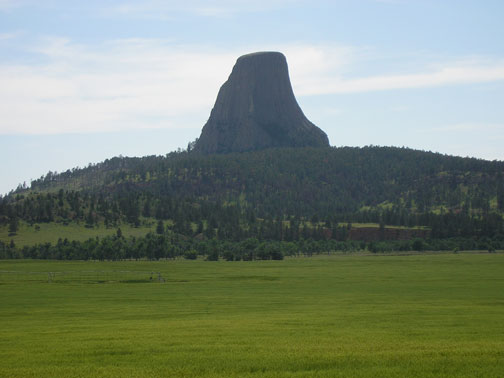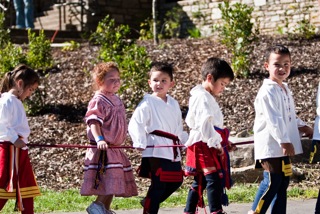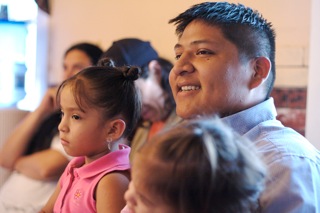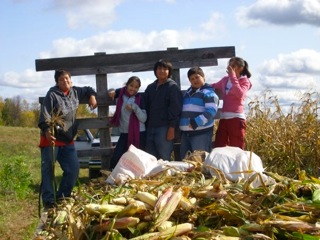Indigenous Peoples’ diverse languages have developed over many thousands of years in close relationship to their ancestral tribal homelands. These many hundreds of languages—scholars estimate as many as 300-500 Indigenous languages were once spoken in North  America—carry detailed knowledge and observations of the natural world, including place names often displaced by much more recent English-language monikers such as Mato Tipila (“Bear Lodge,” in Lakota), renamed “Devil’s Tower” by settlers and the National Park Service. Those first settlers obviously knew the location to be a sacred and powerful ceremonial site to dozens of tribes—and myriad locations from the east to west coast are branded “devils'” places in reference to the Native peoples who once worshipped there enjoying full religious freedom.
America—carry detailed knowledge and observations of the natural world, including place names often displaced by much more recent English-language monikers such as Mato Tipila (“Bear Lodge,” in Lakota), renamed “Devil’s Tower” by settlers and the National Park Service. Those first settlers obviously knew the location to be a sacred and powerful ceremonial site to dozens of tribes—and myriad locations from the east to west coast are branded “devils'” places in reference to the Native peoples who once worshipped there enjoying full religious freedom.
While 139 Indigenous languages are miraculously still spoken today in the U.S.—according to UNESCO’s Atlas of the World’s Languages in Danger—more than 70 are spoken only by the oldest generations of tribal citizens.  Some linguists estimate scarcely two dozen Native languages will still be spoken by mid-century; however, a dedicated Native American languages movement has worked for decades to document, publish in, and promote Native language materials and usage among younger generations. This work follows centuries of overt language discrimination and suppression by settlers and religious denominations who actively worked to exterminate Indian languages and cultures beginning in New England the early 1630s with the first grammar schools and “praying towns” providing refuge and “education” to Indian families and students.
Some linguists estimate scarcely two dozen Native languages will still be spoken by mid-century; however, a dedicated Native American languages movement has worked for decades to document, publish in, and promote Native language materials and usage among younger generations. This work follows centuries of overt language discrimination and suppression by settlers and religious denominations who actively worked to exterminate Indian languages and cultures beginning in New England the early 1630s with the first grammar schools and “praying towns” providing refuge and “education” to Indian families and students.
Later, federally funded Indian boarding schools were opened by the U.S. War Department’s Bureau of Indian Affairs (the Bureau was later moved to the Department of Interior) with an explicit goal to “kill the Indian, save the man,” and children from hundreds of tribes were removed from their communities for years at a time to be trained  largely as an agricultural, domestic, and industrial labor force. Even into the 1970s and 80s, Native children were often harshly punished or ridiculed for speaking their mother tongues, and as a result, successive generations of tribal peoples did not teach their children their heritage languages in order to shield them from the discrimination and corporal punishment they experienced. Today’s Native language teachers and students still face unfair certification and testing practices mandated by more than a decade of prohibitive No Child Left Behind Act regulations, which have continued to undermine Native language classrooms and schools.
largely as an agricultural, domestic, and industrial labor force. Even into the 1970s and 80s, Native children were often harshly punished or ridiculed for speaking their mother tongues, and as a result, successive generations of tribal peoples did not teach their children their heritage languages in order to shield them from the discrimination and corporal punishment they experienced. Today’s Native language teachers and students still face unfair certification and testing practices mandated by more than a decade of prohibitive No Child Left Behind Act regulations, which have continued to undermine Native language classrooms and schools.
Now, with a sense of great urgency, those tribal communities with only a handful of speakers—including the Euchee, Wampanoag, and Sauk—work every day to train  new generations of speakers via intensive language education activities including master-apprentice programs, language immersion classrooms, and intergenerational home-based “language nests” and daycare programs like those pioneered by the Maori and Native Hawaiian language communities. Roughly a dozen speakers of the Wampanoag language—reclaimed from written records including the first bible published in the western hemisphere, and by careful comparison with related languages in the Algonquian “family”—have emerged after more than fifteen years of intensive community-based efforts to return the language to their nation.
new generations of speakers via intensive language education activities including master-apprentice programs, language immersion classrooms, and intergenerational home-based “language nests” and daycare programs like those pioneered by the Maori and Native Hawaiian language communities. Roughly a dozen speakers of the Wampanoag language—reclaimed from written records including the first bible published in the western hemisphere, and by careful comparison with related languages in the Algonquian “family”—have emerged after more than fifteen years of intensive community-based efforts to return the language to their nation.
Linguists group similar and sometimes mutually intelligible languages that share historic characteristics into “families,” but these designations are imprecise simply because so little is still known about these ancient languages. And while a dozen major language families encompass scores of tribal tongues, more than twenty languages are simply known as “isolates,” unrelated to any others in the Americas. There is much to be learned and rediscovered by tribal citizens and rising generations now finally free to speak and actively use mother tongues in public, even while public and tribal schools are still often hobbled by uncooperative state and federal regulations. All Indigenous languages—and Indigenous Peoples’ rights to speak, transmit, and educate their children in these languages—are now protected by an international human rights framework adopted less than one year ago by the United States: the United Nations Declaration on the Rights of Indigenous Peoples. For Native Americans, this is a giant leap forward to protect ancient tongues too long labeled as “backward” impediments to our “progress.”